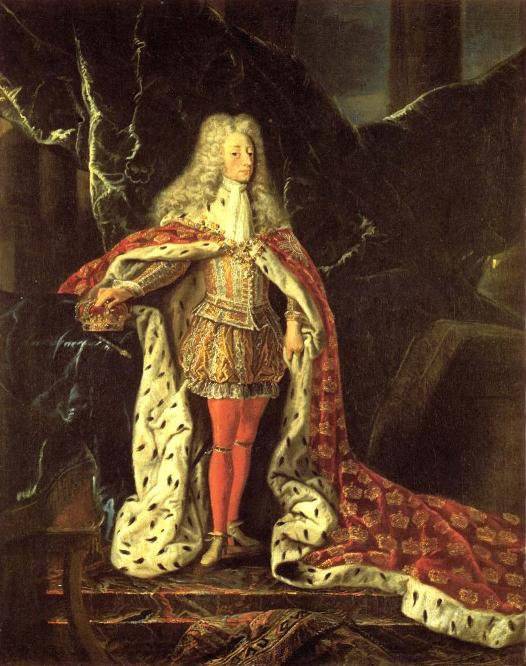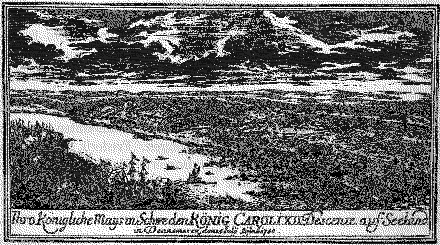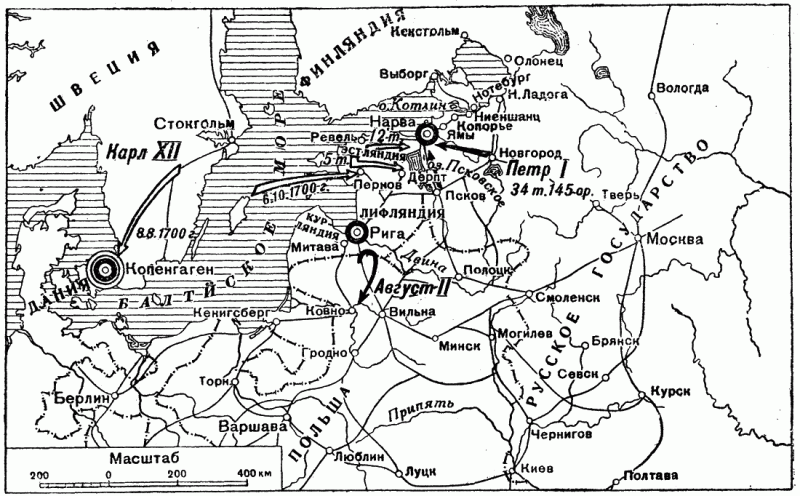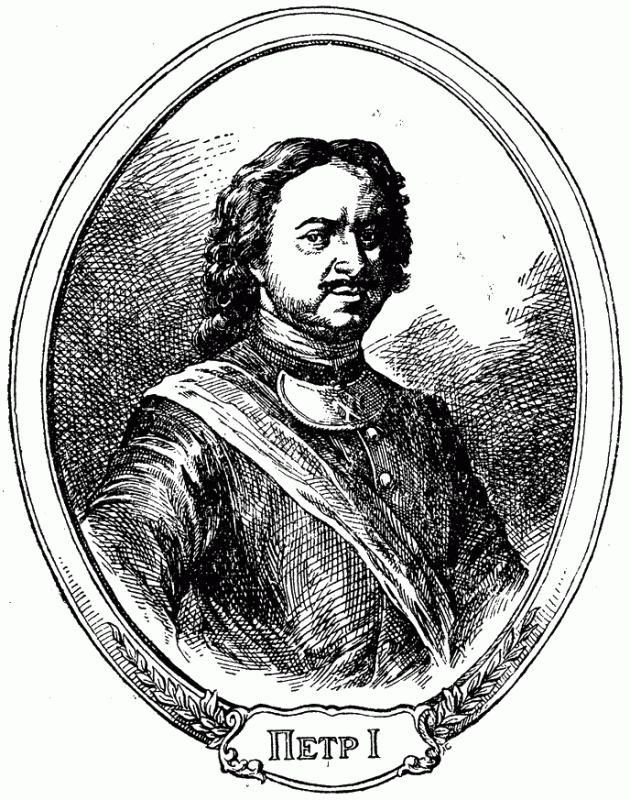The Beginning of the Northern War: The Danish Campaign and the Siege of Narva
The Northern War began with the invasion of Russia's allies in the Swedish possession. At the beginning of 1700, the 7-thousandth Saxon army led by Elector Augustus II, without declaring war, invaded Livonia. Saxons seized the city Dinamünde and besieged the city of Riga. The Danes decided to strike the duchy of Holstein, allied Sweden, having secured themselves from the rear. In March, the 16-thousandth Danish army led by King Frederick IV of Denmark (1699 - 1730) invaded the duchy. The Danes captured the Guzum (Husum) fortress and besieged Tonningen. After the occupation of Holstein, the Danish command planned to seize Pomerania. The Duke asked Charles XII for protection as his relative (the Holstein ruler was married to the elder sister of Charles XII).

Frederick IV (King of Denmark).
Charles XII was not at a loss and began to act actively. The 8th Swedish corps was sent to Pomerania. At the same time, the Swedish king was preparing a strike against Denmark itself; 20 thousand army and 42 ships were concentrated in Karlskrona. At the head of these forces, the Swedish king sailed to the island of Zealand. On April 13, 1700, the Swedish king left Stockholm, to which he was no longer destined to return. Before leaving, Karl established a defense council of several senators. This government agency was supposed to take care of the army, navy and fortresses. The king instructed the Senate to manage all areas within the state that were not related to the military field. Karl himself planned to deal only with war. The Swedish king was taken aboard by the most powerful ship of the Swedish Navy - “King Charles”, he was armed with 120 cannons.
The Swedish fleet stopped at Gumlebek, 7 miles from the Danish capital. On the side of Sweden, unexpectedly for the Allies, the Netherlands and England came out; they sent a united squadron led by Admiral D. Rook to help the Swedes. The British and the Dutch at the Alton Conference in 1689 guaranteed the position of Holstein, and they did not want the Danes to control the Strait of Sunda. The Danish Royal Navy, and he had in its composition 29 battleships and 4 frigate, did not dare to go to sea and give battle.
 24 July (4 August) 1700, the Swedish army landed on the island of Zealand. The commander was General Commander Karl Gustav Renshild, he was the closest adviser to Karl XII on military issues. It was a very courageous decision, since the Danes had a clever and decisive commander, they could thwart this plan (you can recall the battle that gave the Turkish assault force Alexander Suvorov in Kinburn at 1787). The Danes near Gumlebek gathered all the cavalry, behind her in the trenches militia and artillery settled down. The Swedish assault force did not exceed 6 thousand people. King Carl, in spite of the attacks of seasickness that tormented him, personally led the strike force from the 300 grenadiers. From the sea, a fleet covered the landing with artillery fire. Under fire Danes Swedish troops rushed to the shore. The king showed great courage, killed an officer near him and wounded quartermaster general Stuart, one fatal bullet could stop the whole war. The Danes did not actually take the fight and retreated. The construction of earthworks around Copenhagen began, the next day 9 thousand more soldiers were landed.
24 July (4 August) 1700, the Swedish army landed on the island of Zealand. The commander was General Commander Karl Gustav Renshild, he was the closest adviser to Karl XII on military issues. It was a very courageous decision, since the Danes had a clever and decisive commander, they could thwart this plan (you can recall the battle that gave the Turkish assault force Alexander Suvorov in Kinburn at 1787). The Danes near Gumlebek gathered all the cavalry, behind her in the trenches militia and artillery settled down. The Swedish assault force did not exceed 6 thousand people. King Carl, in spite of the attacks of seasickness that tormented him, personally led the strike force from the 300 grenadiers. From the sea, a fleet covered the landing with artillery fire. Under fire Danes Swedish troops rushed to the shore. The king showed great courage, killed an officer near him and wounded quartermaster general Stuart, one fatal bullet could stop the whole war. The Danes did not actually take the fight and retreated. The construction of earthworks around Copenhagen began, the next day 9 thousand more soldiers were landed.Such a powerful fortress like Copenhagen could have defended for a very long time. But several negative factors played a role. First, the Danish leadership did not prepare the capital for defense in advance. Secondly, the Swedish army of Charles XII, numbering in 15 thousand people, the Danes could oppose a garrison of no more than 4 thousand soldiers, the main Danish army led by King Frederick was in Holstein. Thirdly, the townspeople were psychologically not ready to defend the city to the last opportunity, to wait for the arrival of the Danish army. When Charles XII threatened to completely destroy the capital, if the Danes refused to sign the world on his terms, they surrendered. Copenhagen paid Karl a contribution to 400 thousand thalers. And the possibilities for this were: a significant number of guns could be removed from the Danish fleet, strengthening the defense of the capital, sent to the fortifications of sailors, the main army of Denmark was not defeated. The Swedes could not delay the siege, fought against them Saxony, Russia.
7 (18) August 1700, in the Holstein castle of Travendal, peace was concluded. Denmark withdrew troops from Holstein, recognized its sovereignty, and pledged to pay her as compensation for the military losses of 260, thousands of reichstealers. The Danish side refused to union with Saxony and Russia, pledged not to assist the enemies of the Swedish Empire. The overall result of the short Danish campaign was different: the 18-year-old king triumphantly ended the war against the old enemy of Sweden in six weeks (the period of vigorous activity of the main Swedish forces), almost without loss, the army was released for transfer to the Baltic States.
Entry into the war of Russia, the actions of Charles and the Saxon army
Russia, according to agreements with the allies, was going to enter the war after the conclusion of peace with the Ottoman Empire. On August 8 (19), news came that the Russian envoy of Ukrainians had signed an armistice with Porta for 30 years in Istanbul. The next day, Russia declared war on Sweden "for many of their own untruths and most importantly for the most important dishonor perpetrated by the great and plenipotentiary ambassadors in Riga, in the past 1697." Russian troops were moved from Moscow through Novgorod to Narva, which was considered the key fortress of the Swedes in the Baltic states. In principle, the calculation was correct: the fortress on the banks of the Narova River, 12 kilometers from its mouth, was of great importance. The seizure of territory along the Narova line drove a wedge between two Swedish military groups - Livonia-Estland and Karelian. In addition, the fortress of Narva itself was an excellent base for the deployment of offensive operations of the Russian army in Ingria (Ingermanland, Izhora, Izhora land - ethnocultural and historical region located along the banks of the Neva).
Tsar Peter I planned to bring to the Swedish fortress more than 60 thousand people: the regular army, consisting of three divisions under the command of Anikita Repnin, Adam Weide, Avtonom Golovin and Prince Ivan Trubetskoy (about 40 thousand people), local cavalry, including 5-thousand detachment under the command of Boris Sheremetev (total 10 thousand people), and the Cossacks from Ukraine under the command of ataman Ivan Obidovsky (more than 10 thousand people). But for a number of reasons, not all the forces managed to concentrate in Narva, at the time of the battle with Karl. So, the division Repnina were in Novgorod, the Cossacks of Obidovsk in Pskov, Gdov and the Pechora monastery. In addition to these forces, a Russian artillery regiment was part of the Russian army, it consisted of 195 guns, commanded by Tsarevich Alexander Imeretinsky (of the Bagration family). Initially, Field Marshal Avton Golovin was the supreme commander of the Russian army, but this position was nominal, because the tsar himself exercised leadership. For the supply of troops was responsible for the food general Semen Yazykov. At the last moment, the Dutch Duke, Field Marshal Carl-Eugene de Croix, joined the headquarters of the Russian army on the recommendation of the Saxon Elector.
On the way to Narva, the Russian army in September captured the fortress of Yamburg (Yam), Koporye.
The Swedish king, leaving part of the army in Denmark, began to transport the main forces by sea to Livonia (about 10 thousand). The landing point was chosen Pärno (Pernov). From here the Swedish king-commander planned to go to Riga in order to strike at the Saxon troops besieging her. The Saxon ruler, having learned that the Danes were defeated, Denmark was withdrawn from the war, and the victorious Swedish army advanced to Livonia, immediately lifted the siege from Riga and retreated into Polish territory. Therefore, Karl changed his initial plan of action and decided to strike at the Russian army, which laid siege to Narva. Having landed in Parno on October 6, he sent troops to Revel (Tallinn) and further to Narva.
Siege of Narva
Narva was a powerful fortress, representing a single defense system with Ivangorod Castle, on the right bank of the Narova River. Ivangorod and Narva connected the fortified bridge, which allowed the units to move between fortifications, even under siege conditions. This led to the need for the Russian army to block both fortresses simultaneously. The area around the fortress was swampy, it became especially difficult after autumn rains. This dramatically narrowed the possibility of using the Russian cavalry. The fortress itself had powerful fortifications, and heavy siege artillery was needed to make a hole. She defended her garrison of 2 thousand soldiers under the command of Colonel Gorna. The commandant of the fortress of Horn answered the proposal to capitulate with mockery: the colonel was counting on the power of the fortifications, the bravery of the garrison, on the backwardness of the Russian army from the requirements of advanced European experience. Moreover, Gorn received a message about the imminent arrival of Charles XII with the army.
The forward detachment of the Russian army, headed by Prince Prince of Novgorod, Ivan Trubetskoy, arrived in Narva three weeks after the declaration of war - September 9 (20). 23 of September (4 of October), a detachment of Ivan Buturlin arrived to the fortress along with Peter I. 14 (25) of October, units of Avtomon Golovin and the cavalry of Boris Sheremetev arrived. As a result, by the beginning of the hostilities, the Russian command was able to concentrate around the Swedish fortress from 34 to 40 thousands of bayonets and sabers (21 soldiers regiment, 7 archers, 2 dragoons, artillery regiments and a number of other formations).
Russian troops camped on the left bank of the Narva in a single line, which covered the Narva fortress in a semicircle and flanked to the river. Ivangorod was also blocked. The camp was reinforced by a moat and an embankment, the front in 7 kilometers was facing west. The right flank of the Russian army was occupied by units of the Golovin division, the former "amicable regiments", the center — the forces of the Novgorod governor Trubetskoy, the left flank — the units of the Weide division; Sheremetev's nobleman militia took up positions on the tip of the left flank, and he was also tasked with conducting reconnaissance in the Revel direction.
For the organization of the siege of Narva, Augustus II recommended to the Russian Tsar engineer Ludwig Allart, he was cordially received by Peter, he was granted the rank of lieutenant general. August also sent several engineering and artillery officers to control siege operations. The leadership of the siege works the king commissioned foreign military experts. But it soon became clear that foreign engineers did nothing, they constantly interfered with each other by constant arguments and criticism. As a result, Peter himself had to take the leadership of the siege himself, to reach everything himself. Under enemy fire began to build "aproshi" (approaches). In early October, 1700 brought heavy artillery from Pskov and Novgorod. The king personally supervised the selection of places and the installation of guns, controlled the actions of the gunners. I must say that the artillery was in a deplorable state: gun carriages and wheels because of off-road constantly broke, mortars were fired with stones, because the bombs did not match the caliber of guns, the powder was of poor quality. 20 (31) of October, the Russian army began regular shelling of Narva, but within two weeks the charges ran out. In addition, most of the guns were small caliber. They could not cause serious harm to the fortress.


Information